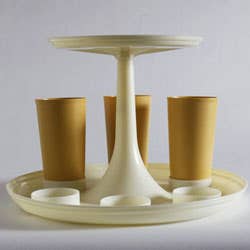
Tupperware Through the Ages
Every 1.5 seconds, somewhere on the planet, a Tupperware party is thrown; nearly $2.6 billion dollars' worth of Tupperware is sold annually in more than 100 markets worldwide. By the numbers alone, the kitchenware company that New Hampshire inventor Earl Tupper founded in 1946 displays its reach. Take a closer look at Tupperware's trajectory, and you can chart the past half-century of kitchen culture in the U.S. and beyond.
Read more about the history of Tupperware »
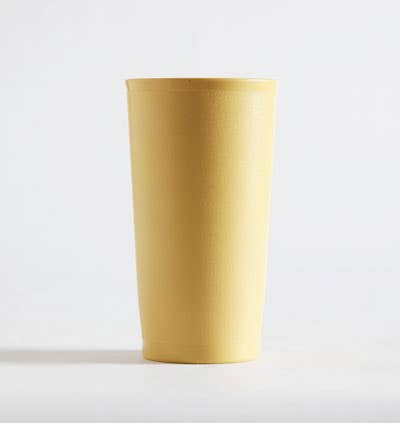
Tupperware products actually had their inception not in the kitchen but on the battlefield; Earl Tupper had worked for DuPont developing the country's first plastics for use in World War II radars. Around 1942, casting about for nonmilitary uses for the flexible material, he created an injection-molded polyethylene cup, which he called the Bell Tumbler. It was introduced to the market in 1946. Todd Coleman
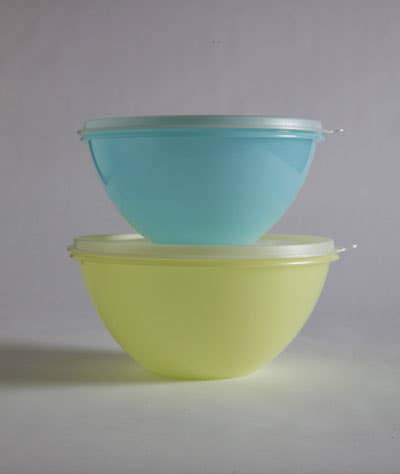
Along with the Bell Tumblers, Tupperware introduced the sealed, nesting Wondelier Bowls. With an 80 percent increase in home refrigeration in the 1940s, food storage proved to be the perfect application for Tupper's durable polymer. The stackable containers organized the fridge and spoke to a growing interest in hygiene; their patented "burping" seal-its name echoing a primary maternal task of 1940s housewives--kept foods fresh. Todd Coleman
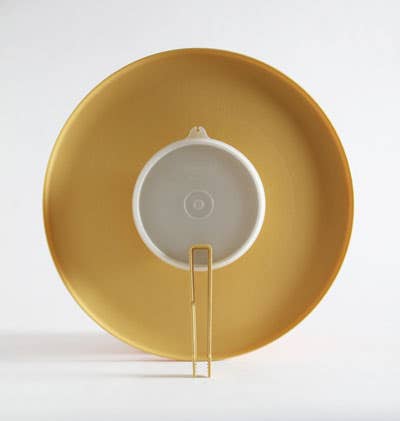
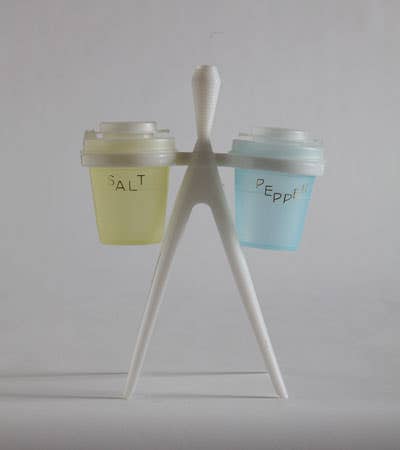
As early as 1947, Tupperware was targeting upwardly mobile consumers with lines like the pastel Millionaire Collection, displayed and sold at the time in department stores. This item, which has an atomic-era style to it, incorporated a small toothpick holder at the top of the stand between the shakers. Todd Coleman
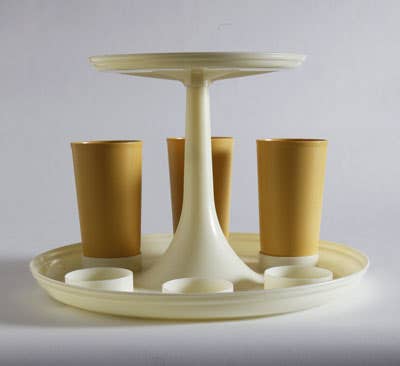
Items like the "soft glowing" 1955 TV Tumblers were made to suit a decade that ended with 50 million televisions in U.S. homes. The Carousel Caddy, a further development in Tupperware's home entertainment products, could hold half a dozen beverage-filled Tumblers securely within the built-in coasters on its bottom tier, while snacks sat on its top tier. A handle at top (not shown) was designed for easy transport from the kitchen to the TV room--or the backyard, an increasingly popular spot for home entertainment. Todd Coleman
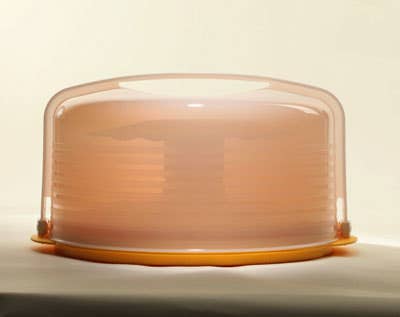
In the 1950s, as backyard barbecues and picnics grew in popularity, Tupperware introduced the Pie Taker, a sealed round storage container for easy transport of homemade desserts to wherever the meal with family and neighbors might take place. This later-model Cake Taker is a descendant of that mid-century design. Jon Whittle
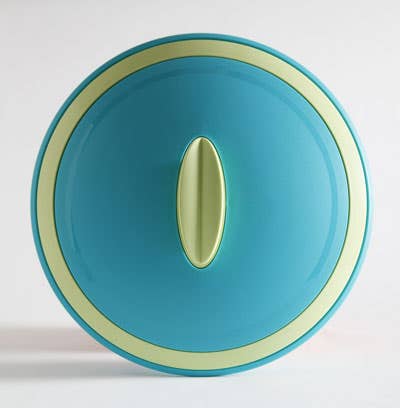
In the jet-set 1960s, Tupperware sought to feed globalizing appetites with domestically marketed "ethnic" items like the Tortilla Keeper, which--like many Tupperware products--has evolved in style through the years but remains in the product catalogue. One way to tell the age of an item? Look at its colors: pieces from the 1940s and '50s are white or pastel, while later items are saturated in bright hues. Todd Coleman
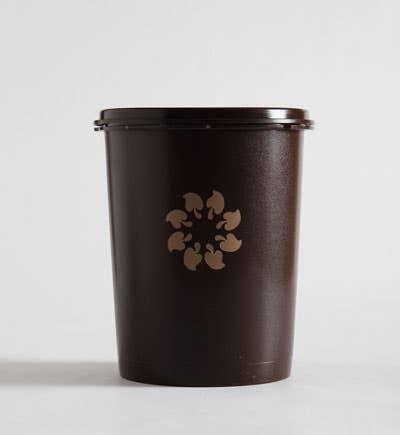
Each of the storage canisters in the Servalier line, which nested within one another in graduated sizes, came with a decorative flower emblem on its smudge-proof textured exterior. With the canisters, like the one "made to order for the larger package of Ritz crackers," Tupperware sought to capitalize on the increasing popularity of packaged foods. Todd Coleman
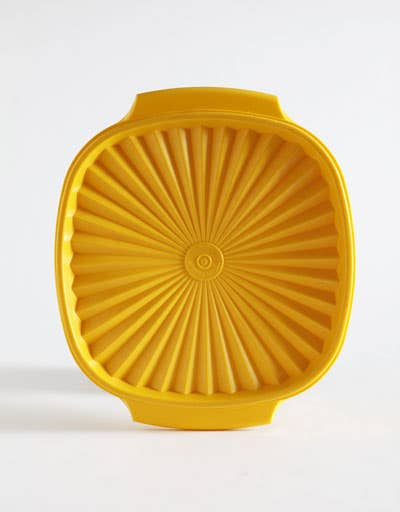
The Servalier canister also came with an "instant touch," air-tight seal that was designed to be closed easily by pushing down on the center of the lid¿s sunburst pattern, a lasting Tupperware feature seen here on the Astro Bowl from a decade later. Todd Coleman
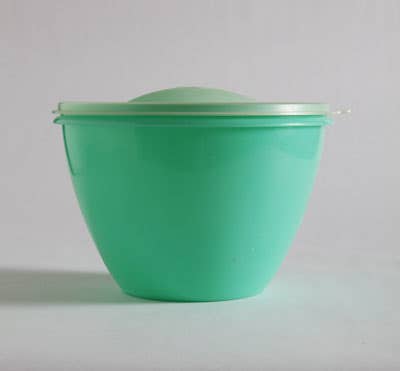
One of Tupperware's strategies for expansion has been to develop items for specialized storage needs. First introduced in the 1960s, this "lettuce keeper" was designed to help greens retain their freshness and color. Inside the bowl was a removable round grate that held a lettuce head stationary on a spike, suspending it above any moisture that might accumulate at the bottom of the bowl. The domed section of its pull-tab seal depressed when sealed to remove excess air, further ensuring crispness. Todd Coleman
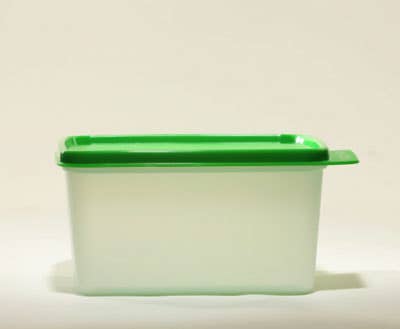
Always more functional than fashionable, Tupperware products reflect the most practical concerns of the world's home cooks: Kimchi Keepers for Korea, ventilated CheeSmart cheese storers for Europe, the microwave-friendly TupperWave Stack Cooker for the fast-paced American market. The new Keep Tabs containers--nesting with their seals on, like Russian dolls, and available in sizes as small as five ounces--were an instant hit in countries like Mexico and Uruguay where kitchens are small and every bit of saved food counts. The sets are just one of 135 new products Tupperware released last year, many of them made with both space-saving and conservation in mind. Jon Whittle
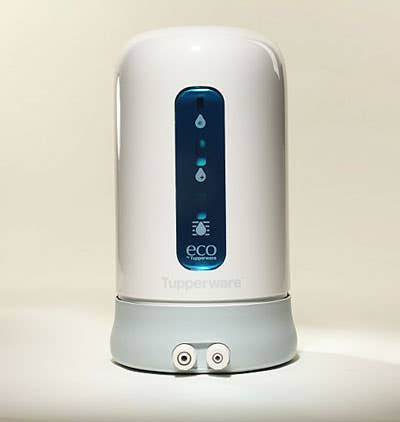
Other new Tupperware items address needs surrounding the planet's most precious beverage and cooking liquid: a water storage unit for Indian households, where tap water is available only a few hours a day; the top-selling, reusable Eco Bottle; and, shown, a countertop filtration system, which cleans industrial pollutants from tap water. Jon Whittle
Keep Reading
Continue to Next Story










